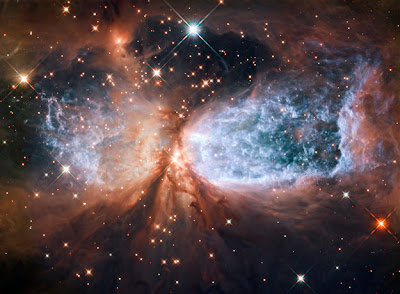A seasonal snow angel soars through the heavens in this beautiful ESA Hubble Space Telescope image of a star-formation region identified as Sharpless 2-106, or S106.
Appearances can be deceiving, however, as behind the delicate façade lies a devilish young star that is ejecting material at a furious rate, disrupting the gas and dust around it.
The central star has a mass of about 15 times that of our own Sun and is in the final stages of its formation.
The outstretched glowing blue wings are created from twin lobes of super-hot hydrogen gas spewing out from the star.
Temperatures here reach 10 000ºC, and contrast against the cool backdrop of interstellar space. A cold belt of dust, appearing red in this image, nearly obscures the central star from view, but it can just be seen peeking through.
Its faint light reflects off tiny dust particles throughout the scene, giving the blue wings the appearance of having red veins.
S106 is 2000 light-years away towards the constellation of Cygnus, and measures about 2 light-years across.
Appearances can be deceiving, however, as behind the delicate façade lies a devilish young star that is ejecting material at a furious rate, disrupting the gas and dust around it.
The central star has a mass of about 15 times that of our own Sun and is in the final stages of its formation.
The outstretched glowing blue wings are created from twin lobes of super-hot hydrogen gas spewing out from the star.
Temperatures here reach 10 000ºC, and contrast against the cool backdrop of interstellar space. A cold belt of dust, appearing red in this image, nearly obscures the central star from view, but it can just be seen peeking through.
Its faint light reflects off tiny dust particles throughout the scene, giving the blue wings the appearance of having red veins.
S106 is 2000 light-years away towards the constellation of Cygnus, and measures about 2 light-years across.







No comments:
Post a Comment